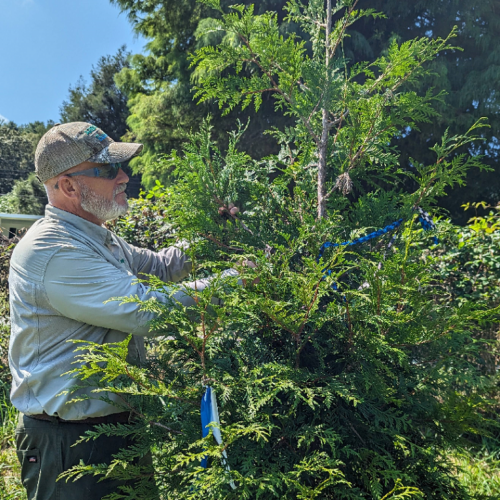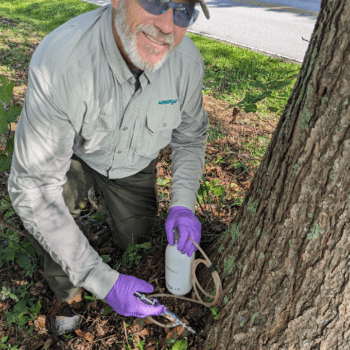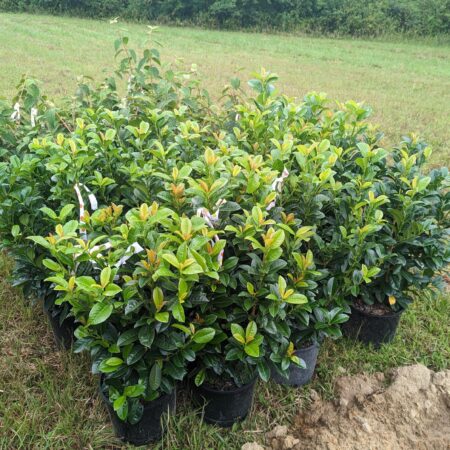This blog features Dr. Don Grosman, who in addition to his role at Arborjet | Ecologel as Technology Advancement Manager, heads up entomology in R&D and employs his thoracic (i.e., muscle) capacity to apply field trials and to evaluate data. This blog gives some rudimentary insight into the efforts involved in developing Arborjet technology.
The Entomological Head:
Since joining Arborjet in 2013, Don Grosman has utilized his broad knowledge of entomology and insect control strategies to help develop the next evolution in plant health technology. He holds a PhD. in Entomology from the Virginia Tech, an M.S. in Forestry from the University of Maine, Orono, and Bachelor of Science in Forest Biology from SUNY-CESF, Syracuse.
Previously, Don served as Coordinator of the Forest Pest Management Cooperative based with the Texas Forest Service (17 years). He has conducted ground-breaking research in protecting the urban and natural forests against pests, including bark beetles, seed and cone insects, pine tip moth, and leaf-cutting ants. He has also discovered the efficacy of emamectin benzoate against several pine bark beetles, ambrosia beetles, and stem gall wasps.
At Arborjet, Don coordinates with Director of Research & Development Dr. Sabesh Kanagalingam and President Russ Davis to identify, develop, and evaluate environmentally friendly and effective products and application systems for United States markets. He conducts laboratory and field bioassays with emphasis on the control of natural and urban forest insects and diseases.
The Thoracic Part:
Field studies pursue testing methods of applications and formulations for plant health care. These methods include systemic tree injection, foliar application, and soil injection technologies.
Although our tree injection technology was developed over 20 years ago, it is constantly being updated. One of our goals is to offer methods and formulations that minimize negative impacts on the environment and on off-target insects. Therefore, we continue development for pollinator-friendly actives and methods of application.
Tree injection technology has certain advantages in application, which include:
- The active ingredient is introduced directly into the trees’ vascular tissues and not into the surrounding environment.
- Applications move into the canopy of tall trees, rather than being reached by high pressure spraying.
- The introduced formulation is protected from photodegradation and leaching into the soil.
- Pests that infest/infect the tree are directly targeted.
- The application interval is from 1 to 3 years, depending upon the pest, compared to once every two weeks for canopy spray applications.
- Less active product is used compared to foliar or soil applications.
- Systemic tree injections are effective against pests that feed under the bark, whereas spray applications are ineffective.

New studies are evaluating the effectiveness of soil injection applications for use with plant growth regulators and liquid fertilizers and soil amendments.

Shrub studies often start off with new plantings. For example, in researching the efficacy of plant growth regulators (PGRs), we evaluate the impact on a cross section of plant cultivars, from easy-to-regulate to difficult-to-regulate. In a recent study, we evaluated the effects on cherry laurel (Prunus laurocerasus) and green giant arborvitae (Thuja plicata), two evergreens that are difficult to regulate.
Plantings are installed in advance of the study to ensure that the plants are well established. Treatments are designed to test differing concentrations of actives in order to determine the most effective dose. For example, in studies we apply from 0.01 to 1000 ppm of product in increasing increments.
At the end of the study, the current years’ growth is compared with the previous years’ growth as a within plant sample, as well as across the study to compare the various concentrations applied.

In this field study, we set up a field lab to take the annual growth metrics.

For studies that surround the effects of soil injection or granular applications of fertilizers, plant tissue samples are taken for lab analyses.

Of the diagnostics conducted, we are at times called to evaluate the cause of a tree’s death. These diagnostics are done in situ, and often involve excising tissue using a chisel and mallet and increment borer to determine the time at which tree health changed.

In recent years, autopsies in ash trees have been conducted to confirm emerald ash borer (EAB) attacks.

The Abdomen (i.e., to conclude):
A prolific author, Don has been published in numerous peer-reviewed journals, is a frequent presenter at conferences, and is a member of various societies and committees including the Entomological Society of America and the International Society of Arboriculture – Texas. Don has been recognized with several awards such as the Forest Research Award and the Vice Chancellor’s Award for Excellence in Professional Services.
Don is an asset to the Arborjet | Ecologel team, and we are happy to have him as an integral member of the R&D group!
Join us next week when we get into an appropriate fall topic for the season.
~ Signing off for now, Joe



